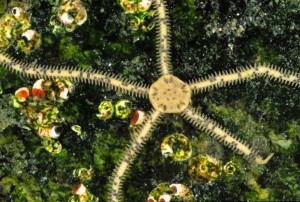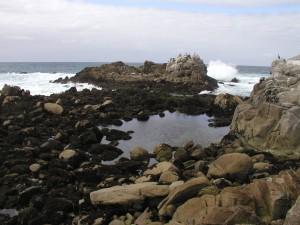
Since the 1980s, most of the brittle stars in the intertidal zone around southern Monterey Bay – from Point Pinos to Carmel Point – seem to have disappeared. Evidence of this trend comes from observations and scientific studies completed before and after the mid-late 1980s, when intertidal brittle star numbers seem to have begun to decline. From 1981 to 1982, Steven Rumrill investigated the reproductive biology of five brittle star species for his masters thesis under Dr. John Pearse at UCSC. Rumrill’s study included two intertidal species, Amphipholis squamata and Amphiodia occidentalis, that he collected in the Great Tide Pool (36.638361°, -121.938247°) in Pacific Grove. He had no trouble collecting 10 to 20 brittle stars monthly for his analyses over the course of a year by simply rolling boulders and scooping up handfuls of them. A. squamata, a very small, self-fertilizing hermaphrodite found all over the world, was particularly abundant, with a density of up to 575 per square meter recorded. At one point over 160 A. squamata were collected under one small boulder. In 1998, a student from New Zealand was studying the genetics of A. squamata, and asked Dr. John Pearse to collect some specimens for her from around Monterey Bay. John and his wife, Dr. Vicki Pearse, were astonished to find only five specimens in an hour’s search around the Great Tide Pool. In the following years, they kept their eyes out for both A. squamata and A. occidentalis. The decrease in abundance of intertidal brittle stars has continued through 2011, with A. squamata all but gone and A. occidentalis diminished but somewhat easier to find (J. Pearse, personal communication). Pearse reported this decline in his Ed Ricketts Memorial Lecture at the 2004 Sanctuary Currents symposium. Another species that has all but disappeared from the intertidal zone is a small, bright red acoel flatworm that is endemic to the Monterey Peninsula, Polychoerus carmelensis. The species was first described in the 1930’s, and was extremely abundant in the high tide pools at Point Pinos and Carmel Point in the 1960s and 1970s. It gradually decreased in numbers, and around the year 2000 local biologists began to suspect it might be extinct. Eventually a few pockets were detected where P. carmelensis still seemed to be fairly common, but hardly conspicuous like it was before (J. Pearse, personal communication). Organisms living in the intertidal zone are highly adapted to exist in the face of both ocean and land-based threats, and are vulnerable to human impacts in ways that other marine life is not. However, the role that humans have played in changing the abundance of some tidepool species is largely unknown. Some have pointed to trampling and illegal collecting as problems, but these activities are less likely to directly affect habitats underneath rocks. It is possible that these changes are a result of warming ocean temperatures. Stanford professor emeritus Dr. Chuck Baxter has observed many changes in the intertidal, and in a 2004 interview recounted “there used to be a riot of life under the rocks – brittle stars, peanut worms, chitons, flatworms, and sea cucumbers.” Many of the species he once observed are gone and have been replaced by species formerly known to only exist in areas further south. As an example, Baxter has observed an increased abundance of ragged pink volcano limpets in the lower intertidal, while the local porcelain crab Petrolisthes cinctipes has all but disappeared. From 1993-1994, Stanford researcher Rafe Sagarin investigated the same protected pools behind Pacific Grove’s Hopkins Marine Station that had been studied by Stanford student Willis Hewatt from 1931 to 1933. Comparing his data with Hewatt’s, he found that although the tidepools still had high species diversity and comparable numbers of plants of animals, species composition had changed dramatically. Of 45 invertebrate species, eight of nine southern species – such as sunburst anemones, green urchins, the red barnacle Tetraclita rubescens and the green chiton Cyanoplax hartwegii – had increased, while five of eight northern species – such as ochre sea stars – had decreased. These results seem to correlate with a trend toward warming local waters. During those 60 years, local water temperature had risen by 1.3°F, and by nearly 4°F in the summer. Since the intertidal zone at Hopkins is off limits to tidepooling, this study seems to indicate that factors other than direct human impacts have caused changes in intertidal zone species abundance and composition.

For more information: Barry, J. P., C. H. Baxter, R. D. Sagarin, and S. E. Gilman. 1995. Climate-Related, Long-Term Faunal Changes in a California Rocky Intertidal Community. Science, New Series, Vol. 267, No. 5198 (Feb. 3, 1995). Rumrill, S. S. and J. S. Pearse. 1985. Contrasting reproductive periodicities among north-eastern Pacific ophiuroids. Proceedings of the Fifth International Echinoderm Conference/Galway/24-29 September 1984. Available at the library of Hopkins Marine Station.